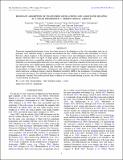Files in this item
Resonant absorption of transverse oscillations and associated heating in a solar prominence. I. Observational aspects
Item metadata
| dc.contributor.author | Okamoto, Takenori J. | |
| dc.contributor.author | Antolin, Patrick | |
| dc.contributor.author | De Pontieu, Bart | |
| dc.contributor.author | Uitenbroek, Han | |
| dc.contributor.author | Van Doorsselaere, Tom | |
| dc.contributor.author | Yokoyama, Takaaki | |
| dc.date.accessioned | 2017-02-14T12:30:13Z | |
| dc.date.available | 2017-02-14T12:30:13Z | |
| dc.date.issued | 2015-08-11 | |
| dc.identifier | 248969371 | |
| dc.identifier | 5cfc859f-0395-40fa-8d6d-efb736a560ad | |
| dc.identifier | 84945268671 | |
| dc.identifier.citation | Okamoto , T J , Antolin , P , De Pontieu , B , Uitenbroek , H , Van Doorsselaere , T & Yokoyama , T 2015 , ' Resonant absorption of transverse oscillations and associated heating in a solar prominence. I. Observational aspects ' , Astrophysical Journal , vol. 809 , no. 1 , 71 . https://doi.org/10.1088/0004-637X/809/1/71 | en |
| dc.identifier.issn | 0004-637X | |
| dc.identifier.other | BibCode: 2015ApJ...809...71O | |
| dc.identifier.uri | https://hdl.handle.net/10023/10294 | |
| dc.description.abstract | Transverse magnetohydrodynamic waves have been shown to be ubiquitous in the solar atmosphere and can, in principle, carry sufficient energy to generate and maintain the Sun's million-degree outer atmosphere or corona. However, direct evidence of the dissipation process of these waves and subsequent heating has not yet been directly observed. Here we report on high spatial, temporal, and spectral resolution observations of a solar prominence that show a compelling signature of so-called resonant absorption, a long hypothesized mechanism to efficiently convert and dissipate transverse wave energy into heat. Aside from coherence in the transverse direction, our observations show telltale phase differences around 180° between transverse motions in the plane-of-sky and line-of-sight velocities of the oscillating fine structures or threads, and also suggest significant heating from chromospheric to higher temperatures. Comparison with advanced numerical simulations support a scenario in which transverse oscillations trigger a Kelvin–Helmholtz instability (KHI) at the boundaries of oscillating threads via resonant absorption. This instability leads to numerous thin current sheets in which wave energy is dissipated and plasma is heated. Our results provide direct evidence for wave-related heating in action, one of the candidate coronal heating mechanisms. | |
| dc.format.extent | 12 | |
| dc.format.extent | 2553208 | |
| dc.language.iso | eng | |
| dc.relation.ispartof | Astrophysical Journal | en |
| dc.subject | Sun: chromosphere | en |
| dc.subject | Sun: transition region | en |
| dc.subject | Waves | en |
| dc.subject | QB Astronomy | en |
| dc.subject | QC Physics | en |
| dc.subject | NDAS | en |
| dc.subject.lcc | QB | en |
| dc.subject.lcc | QC | en |
| dc.title | Resonant absorption of transverse oscillations and associated heating in a solar prominence. I. Observational aspects | en |
| dc.type | Journal article | en |
| dc.contributor.institution | University of St Andrews. Applied Mathematics | en |
| dc.identifier.doi | 10.1088/0004-637X/809/1/71 | |
| dc.description.status | Peer reviewed | en |
| dc.identifier.url | http://adsabs.harvard.edu/abs/2015ApJ...809...71O | en |
This item appears in the following Collection(s)
Items in the St Andrews Research Repository are protected by copyright, with all rights reserved, unless otherwise indicated.

